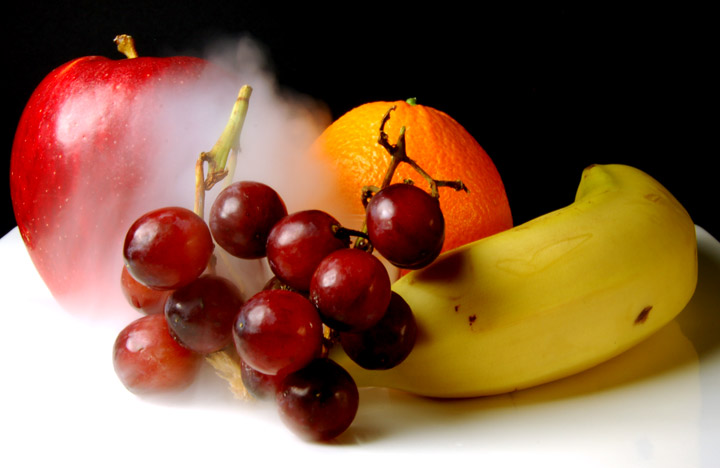Carbonated Fizzy Fruit
Have you ever tried grapes that taste like Champagne or oranges that taste like Fanta? You can easily do this at home by making grapes and oranges fizzy. You can also try other fruits and vegetables. Some will taste better than others when fizzy. Grapes, oranges, apples, bananas taste great when they are fizzy but strawberries, for example, taste as if they’ve gone bad.
Before we discuss how to make fruit fizzy, lets understand what makes sparkling water fizzy first. The fizzy sensation comes from the bubbles of concentrated carbon dioxide (CO2) which, as they burst in the mouth, they trigger a pain response from the nerves in the tongue and the mouth.

Interesting Fact I: This nerve response also intensifies the aromas and taste. This is why beverages taste blander after they lose its carbonation.
Interesting Fact II: The colder the liquid the more CO2 that can dissolve in it. So if you want to keep your beverage carbonated for a longer period, just keep it cold.
Interesting Fact III: Most beers have CO2 bubbles but Guinness beer bubbles contain nitrogen instead so it doesn’t taste fizzy. The nitrogen is also less soluble than CO2 which allows the beer to be put under high pressure without making it fizzy which enables small bubbles to be formed. Both effects give draught Guinness its perceived smoothness.
So how can we carbonate fruit at home so it tastes fizzy? You can do this with some dry ice or with a soda siphon or ISI Whip.
Carbonating Fruit with Dry Ice
Dry ice is frozen carbon dioxide at a temperature around -78 ˚C (-108 ˚F). Dry ice does not melt but sublimates from a solid to a gas when the temperature rises. This gas is pure CO2, exactly what we need to carbonate the fruit. Follow the next steps to make the fruit absorb the CO2.
1- Cut the fruit in bite size pieces as if you were making a fruit salad. Grapes can be kept whole. This is to speed the carbonation process and increase the level of carbonation.
2- If you have dry ice in pellets, you can use them as is. If you have a dry ice block, smash it with a hammer or use an ice pick to obtain small chunks. Place the dry ice pellets or chunks at the bottom of a bowl or container. Read Safe Handling of Dry Ice before doing this.
3- Place the fruit on top of the dry ice. To prevent the fruit from freezing you can place it on a small wood chopping board and then place the board on top of the dry ice. If the fruit freezes you will have to wait for it to thaw before eating it. In some situations you may want to let it freeze so you can use it instead of ice cubes in a beverage that will have fizzy fruit as it thaws (try frozen grapes with Champagne).
4- Cover the container with a kitchen towel or cutting board but DO NOT SEAL the container with a tight lid or CO2 pressure will build up as the dry ice sublimes and it MAY EXPLODE.
5- Let it rest for about 30 minutes. As the dry ice sublimes and converts into gas, the CO2 will dissolve in the water of the fruit. The dry ice will keep the fruit cold, allowing more CO2 to dissolve in the fruit. If the fruit freezes, wait for a few minutes before eating or you will burn your tongue.
Carbonating Fruit in Soda Siphon or ISI Whip
Another method of carbonating fruit is to use a soda siphon or ISI Whip. This method results in more carbonated fruit than the dry ice method thanks to the pressure in the container. Do not try pressurizing a container that has not been designed to withstand high pressures.
1- Cut the fruit in bite size pieces as if you were making a fruit salad. Grapes should be cut in half or they will burst due to the pressure and thin skin. This is to speed the carbonation process and increase the level of carbonation.
2- Place the fruit in a soda siphon or ISI Whip and charge it with CO2. If using an ISI Whip, do not charge it with the N2O cream chargers or the fruit will not taste fizzy. Charge the ISI Whip with the CO2 ISI soda chargers which are the same size as the cream chargers.
3- Store the soda siphon or ISI Whip in the fridge to keep it cold and increase the amount of CO2 that dissolves in the fruit. Keep it in the fridge overnight.
4- Release the pressure in the siphon or ISI Whip before unscrewing the top.
5- Unscrew the top and serve. Fruit should be eaten within 15 minutes or the carbonation will be lost.
Serving Suggestions
- Try fizzy grapes with champagne or with cheese
- Carbonate the grapes on the vine
- Try sangria with fizzy fruit
- Try carbonating spherification spheres like the Spherical Pear Elderflower Martini
- Try carbonated melon with Prosciutto





 (12 votes, average: 3.83)
(12 votes, average: 3.83)
